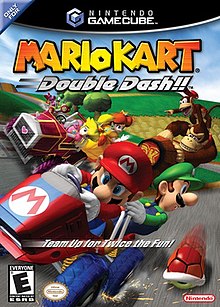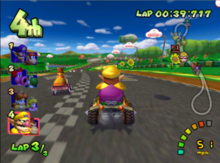Mario Kart is a series of kart racing games and a spin-off Mario franchise developed and published by Nintendo. Players compete in go-kart races while using various power-up items. It features characters and courses mostly from the Mario series as well as other gaming franchises such as The Legend of Zelda, Animal Crossing, F-Zero, Excitebike, and Splatoon.

Super Mario Kart is a kart racing game developed and published by Nintendo for the Super Nintendo Entertainment System (SNES). The first game in the Mario Kart series, it was released in Japan and North America in 1992, and in Europe the following year in 1993. Selling 8.76 million copies worldwide, the game went on to become the fourth best-selling SNES game of all time. Super Mario Kart was re-released on the Wii's Virtual Console in 2009, on the Wii U's Virtual Console in 2013, and on the New Nintendo 3DS's Virtual Console in 2016. Nintendo re-released Super Mario Kart in 2017 as part of the company's Super NES Classic Edition.

Mario Kart: Super Circuit is a 2001 kart racing game for the Game Boy Advance (GBA). It is the third Mario Kart game and retains its predecessors' gameplay: as a Mario franchise character, the player races opponents around tracks based on locales from the Super Mario platform games. Tracks contain obstacles and power-ups that respectively hamper and aid the player's progress. Super Circuit includes various single-player and multiplayer game modes, including a Grand Prix racing mode and a last man standing battle mode.

Mario Kart 64 is a kart racing video game developed and published by Nintendo for the Nintendo 64 (N64). It is the second main entry in the Mario Kart series and is the successor to Super Mario Kart (1992) for the Super Nintendo Entertainment System. It was released in Japan on December 14, 1996; in North America on February 10, 1997; in the United Kingdom on June 13, 1997; and in Europe on June 24, 1997. It was released for the iQue Player in China on December 25, 2003. It was released on the Wii and Wii U Virtual Console in 2007 and 2016, and on the Nintendo Switch Online + Expansion Pack on October 25, 2021.
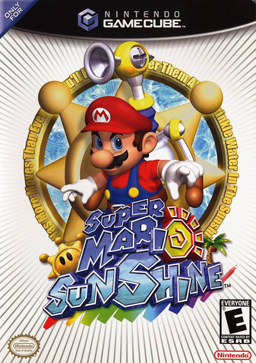
Super Mario Sunshine is a 2002 platform game developed and published by Nintendo for the GameCube. It is the second 3D game in the Super Mario series, following Super Mario 64 (1996). The game was directed by Yoshiaki Koizumi and Kenta Usui, produced by series creators Shigeru Miyamoto and Takashi Tezuka, written by Makoto Wada, and scored by Koji Kondo and Shinobu Tanaka.
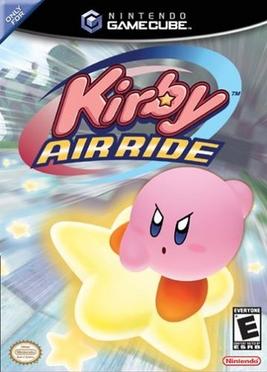
Kirby Air Ride is a 2003 racing video game starring Kirby, developed by HAL Laboratory and published by Nintendo for the GameCube.
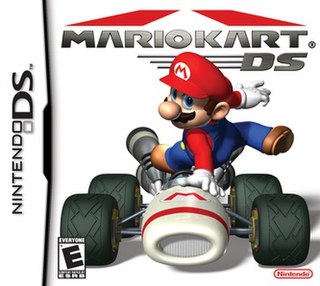
Mario Kart DS is a 2005 kart racing video game developed and published by Nintendo for the Nintendo DS handheld game console. It was released in November 2005 in North America, Europe, and Australia, and on December 8, 2005, in Japan. The game was re-released for the Wii U's Virtual Console in North America and PAL regions in April 2015 and in Japan in May 2016. The game is the fifth main entry in the Mario Kart series of video games, and the first to be playable via the Nintendo Wi-Fi Connection online service. Like other games in the series, Mario Kart DS features characters from the Mario series and pits them against each other as they race in karts on tracks based on locations in the Mario series.
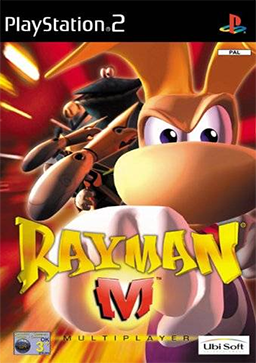
Rayman M, known in North America as Rayman Arena, is a party video game developed and published by Ubisoft. A spin-off of the Rayman series, it features two modes, racing and battle, in which players take control of one of eighteen characters from the Rayman series. The game retains elements from the 1999 platform game Rayman 2: The Great Escape such as, the game's control system.
Mario Kart Arcade GP is sub-series of arcade games from Nintendo's Mario Kart series developed specifically for arcades in collaboration with Namco. To date, four entries have been released - Mario Kart Arcade GP (2005), Mario Kart Arcade GP 2 (2007), Mario Kart Arcade GP DX (2013), and Mario Kart Arcade GP VR (2017). The first three entries are considered to be relatively rare outside of Japan, with the fourth title not seeing a release outside of Japan at all. The game's have been generally been well-received by critics, who have praised the game's transition of traditional Mario Kart gameplay into an arcade game format, thought to-date, while lamenting that none of the entries have been released outside of the arcade format onto any of Nintendo's home video game consoles.

Crash Nitro Kart is a 2003 kart racing game for the PlayStation 2, Xbox, GameCube, and Game Boy Advance; versions for the N-Gage and mobile phones were released in 2004. It is the second racing game in the Crash Bandicoot series after Crash Team Racing and the first game in the series to feature full motion videos.

Konami Krazy Racers is a kart racing video game published and developed by Konami for the Game Boy Advance handheld video game console. It was first released in Japan, and was later released in North America and some PAL regions. It was also re-released for Wii U Virtual Console on October 15, 2015 in Europe. It was a launch game for the system. Konami Krazy Racers makes use of a variety of characters and concepts from several of Konami's franchises, including Castlevania, Metal Gear, and Gradius. It plays similarly to the Mario Kart series, with eight characters per circuit and offensive/defensive items placed at predetermined points in the tracks.

Mickey's Speedway USA is a Disney racing game for the Nintendo 64 and Game Boy Color, developed by Rareware and published by Nintendo under license from Disney Interactive. It is styled after other kart racers such as Mario Kart 64 and Diddy Kong Racing, and features characters from the Mickey Mouse universe racing across the United States. It is Rare and Nintendo's second Disney-themed racing game following Mickey's Racing Adventure (1999).

The GameCube is one of Nintendo's home video game consoles and part of the sixth generation of video game consoles. Although the competing PlayStation 2 and Xbox consoles supported substantial amounts of online games, the GameCube had only eight games with internet or local area network (LAN) support. Nintendo never commissioned any servers or internet services to interface with the console, but allowed other publishers to do so and made them responsible for managing the online experiences for their games. Nintendo remained pensive with its online strategy for the duration of the GameCube's lifespan, defiant of growing interest from players and the success of Microsoft's Xbox Live online service. Company leaders including Shigeru Miyamoto and Satoru Iwata based their stance on concerns with maintaining quality control over their games and doubts that players would want to pay subscription fees.

Donkey Kong Barrel Blast is a 2007 racing game for Nintendo's Wii video game console. The game was shown at the E3 convention in May 2006 for the GameCube under the title of DK: Bongo Blast, but this version was ultimately cancelled in favor of a Wii release. It was released for the Wii in Japan and the United States in 2007, and in PAL regions in 2008 with the title Donkey Kong Jet Race.

Mario Kart Wii is a 2008 kart racing game developed and published by Nintendo for the Wii. It is the sixth installment in the Mario Kart series, and was released in April 2008. Like its previous installments, Mario Kart Wii incorporates playable characters from the Mario series, who participate in races on 32 different race tracks using specialized items to hinder opponents or gain advantages. The game features multiple single-player and multiplayer game modes including two- to four-person split screen. Online multiplayer was supported until the discontinuation of Nintendo Wi-Fi Connection in May 2014. Mario Kart Wii uses the Wii Remote's motion-controls to provide intuitive and conventional steering controls. Each copy of the game was bundled with the Wii Wheel accessory to augment this feature and mimic a steering wheel.

Super Smash Bros. Melee is a 2001 crossover fighting video game developed by HAL Laboratory and published by Nintendo for the GameCube. It is the second installment in the Super Smash Bros. series. It features characters from Nintendo video game franchises such as Mario, The Legend of Zelda, Star Fox, Pokémon, and Donkey Kong among others. The stages and gameplay modes reference or take designs from these franchises as well.

Shrek Smash n' Crash Racing is a kart racing video game released in November 2006. The game is based on the Shrek franchise. Players have the option of playing one of twelve Shrek characters, using racing and combat skills to defeat other racers. It was released for the GameCube, PlayStation 2, PlayStation Portable, Nintendo DS, and Game Boy Advance systems. Shrek Smash n' Crash Racing was the final game based on a DreamWorks Animation film to be released on the GameCube.

Mario Kart 7 is a 2011 kart racing video game developed by Nintendo EAD in cooperation with Retro Studios and published by Nintendo for the Nintendo 3DS. As with the previous games in the Mario Kart series, players participate in racing on various Mario-themed tracks, playing as one of seventeen different Mario characters. While racing, the players make use of power-up items that either assist their character or hinder opposing characters. New additions to the game include hang-gliding attachments for karts, the ability to drive underwater, the ability to drive in first person, and the ability to fully customize the vehicles' builds. The game supports both local and online multiplayer for up to eight players. The game was a critical and commercial success, with it going on to be the best-selling game on the Nintendo 3DS, with over 18.98 million copies sold worldwide.

Banjo-Pilot is a 2005 kart racing video game for the Game Boy Advance (GBA) and the fourth instalment in Rare's Banjo-Kazooie series. It plays similarly to the Mario Kart series by Nintendo: the player races one of nine playable characters around tracks, attacking other racers with bullets and collecting power-ups. The game features a number of single-player and multiplayer modes, such as time attack and item hunts. Unlike other kart racing games, characters control airplanes instead of go-karts.

Mario Kart 8 is a 2014 kart racing game developed and published by Nintendo for the Wii U. It retains the gameplay of previous games in the Mario Kart series, with players controlling a Mario franchise character in races around tracks. Tracks are themed around locales from the Super Mario platform series and are populated with power-ups that help players gain advantages in races. Different difficulties are selectable prior to a race; harder difficulties make gameplay faster. In the new anti-gravity sequences, players drive on walls and ceilings. Mario Kart 8 contains a variety of single-player and local and online multiplayer games modes, including Grand Prix racing and arena-based battle modes.
